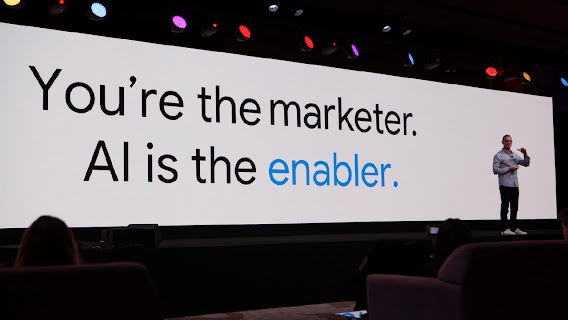At the Interactive Advertising Bureau (IAB) 2024 Annual Leadership Meeting, Jason Spero, Google’s VP of global business, shares reflections from the past and actions to take today to start putting AI to work. Watch the full keynote.

We find ourselves in a moment where AI makes things seem both less certain and more possible, which reminds me of how I felt around 2010, as we tried to understand what the shift to mobile meant for us.
The new technology and new user behaviors that mobile enabled meant we had to evolve our work. But that wasn’t all, because things were happening fast. I was new to the company and was being asked to reimagine relevance, measurement, formats, and the core fundamentals of many of Google’s Ads offerings. It was a time of disruption, excitement, lots of anxiety, and plenty of unknowns. We faced new technology, new user behaviors, and we had to change how we worked.
We face a similar moment today, as AI is primed to help us reimagine what marketing — and marketers — can do. And everyone in the digital advertising universe — marketers, publishers, agencies — has a critical role to play in defining the next era of AI-powered growth.
In 2023, we started to imagine what AI would mean for the future of marketing. 2024 marks an inflection point where we must act to transform those dreams into reality.
Change is hard, of course. It requires a willingness to take smart risks, to experiment, to keep up with industry best practices, and to scale what works. Just as we navigated the mobile shift, we are here together to tackle this AI inflection point. There are actions you can take today to put Google AI to work for your marketing across measurement, media, and creative.
Measurement & data
AI can only be as good as the data you put into it. With high-quality, consented, first-party data, you can build durable measurement for an AI-powered, privacy-first future. To build that data, marketers need to forge new relationships with customers — relationships that are earned, not bought — and which are built on trust and a true value exchange.
And as traditional data sources, namely third-party cookies, go away, your high-quality, first-party data will be especially crucial.
In just 18 months using this approach, PepsiCo increased its global first-party data record by 50%.
PepsiCo is a great example of how a legacy brand is getting its data ready for the next century. Since many of PepsiCo’s brands haven’t typically had direct relationships with consumers, they’ve been developing innovative ways to build first-party relationships, like using QR codes on packaging and in stores to connect customers with their rewards programs. This helps PepsiCo leverage first-party data to find deeper audience insights and shift from purely transactional shopper relationships to something more long term and more profitable.
In just 18 months using this approach, PepsiCo increased its global first-party data record by 50%. It also unlocked 2X ad recall for campaigns that leveraged the first-party data. PepsiCo has been able to use AI-powered Audience Expansion tools to find new likely customers, similar to their best existing customers, and drive 37% higher sales lift on YouTube.
Media
No matter how much consumer behavior fragments, marketing’s fundamental role is still to make customer connections and to translate demand into profitable growth. This is another area where you can put Google AI to work for you to find your highest value customers across devices, platforms, and demographics.
Google AI can take into account your audiences, creative, formats, channels, and placements to discover the best return on your investment, and even discover new customers.
We’re building tools that use AI to work backward from your goals. Instead of building audiences by targeting groups, say “18- to 25-year-old women with an interest in pickleball,” now you can effectively say, “Sell my product profitably to whomever is interested.” Google AI can take into account your audiences, creative, formats, channels, and placements to discover the best return on your investment, and even discover new customers.
We use our own tools in-house too. Google Cloud’s marketers harnessed the power of AI to find business decision-makers who were interested in signing up to trial the platform. Cloud knew their business goal — find new customers — and used that as their KPI.
They then fed Google’s Performance Max tool with key audience signals and an array of creative assets. AI found new customers, and Performance Max was able to fill the gaps that our traditional channel mix missed. The campaign cost per acquisition was 36% lower than the average of our traditional channel mix, and the conversion lift measurement demonstrated an incremental gain of 52%, showing it was finding new customers we would have otherwise missed.
Creative
Creativity, of course, is at the heart of marketing. But it’s impossible for humans alone to generate creative at the volume, velocity, and variation required to meet consumers’ expectations of relevance and to do it at scale. It’s a tremendous drain on creative resources, taking time away from higher value work like focusing on breakthrough creative or better understanding your customers’ needs.
This is where AI shines. Using generative AI, marketers are developing creative in ways never before possible, at speeds unimaginable just a few years ago. We’re building AI solutions like Flip Video and Trim Video to take your existing hero creative assets, and customize and scale them for every platform, device, and customer to increase your results — all in a privacy-safe way.
AI can even help you create new assets that are tailored to make your products relevant for individual potential customers. For example, our new virtual try-on tool for apparel allows users to see how a top will look on models with different body sizes and shapes, from XXS to XXXL. It lets you see how a piece of clothing will drape, cling, and stretch, even down to the wrinkles and shadows, on a range of body types. While the output is a result of synthetic generation, the models are all professionally photographed, real people.
Our virtual try-on tool shows tops, from brands like Everlane, on real models.
Putting AI to work, together
We are deeply optimistic that AI-powered tools can help you meet this moment of extreme disruption and change. That’s why we’re working to reimagine measurement, media, and creative with AI.
As an industry, we’re in this together. We know that every marketer, publisher, and agency is building too. New solutions that enable a balance between privacy, marketing, and publishing will come from teams like yours.
This is our shared challenge — to build a trusted digital marketing ecosystem for the next 25 years and beyond. By rising to this moment, we can finally deliver on the promise of relevance at scale for every customer, without draining our teams or compromising on trust and safety. We can and will empower marketers as a reliable driver of profitable growth. We can and will build value exchange with publishers to support personalization. The time to put AI to work for all of us is now.


